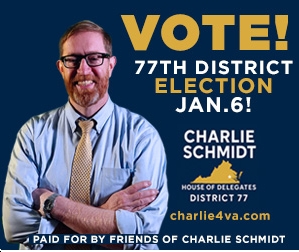This past November, the book “What the Eyes Can’t See: Ralph Northam, Black Resolve, and a Racial Reckoning in Virginia” was published, with its author – former reporter and editorial writer for the Virginian-Pilot Margaret Edds – speaking at a Library of Virginia event with Pulitzer Prize–winning journalist Michael Paul Williams (see video below), on the NewsHour (see video, below), on Roland Martin’s show (see video, below), etc. I strongly recommend these interviews, as they’re all excellent, but I also really wanted to read the actual book…which I finally got around to doing over the past few days. And it was well worth it – STRONGLY recommended to everyone interested in Virginia politics, systemic racism, the incredibly dramatic and eventful history of the Northam administration, etc. In other words, everyone who reads this blog should be highly interested in Edds’ book.
I’m not going to do a comprehensive review of the book – you can read a well-written review, by Peter Galuszka, here. Instead, here are a few things that jumped out at me, some very strongly, as I read the book.
- I agree 100% with Peter Galuszka that Ralph Northam ended up, for a number of reasons, as “arguably the most consequential governor in Virginia’s recent history.” Actually, I’d go further than that, and argue that Northam was BY FAR the most consequential governor in Virginia’s recent history, and BY FAR – seriously, it’s not even close – the most progressive governor in ALL of Virginia history, signing into law (and, before that, playing a major role in passing the bills!) literally HUNDREDS of pieces of progressive, environmental, etc. legislation on a vast array of topics. Just a short list of Northam’s four years leading Virginia through an extremely tumultuous period includes: several major political scandals (including Northam’s own “Blackface” scandal, plus serious allegations of sexual assault against LG Justin Fairfax); Democrats taking control of the General Assembly, with the first woman (Eileen Filler-Corn) in Virginia history becoming Speaker, the first Black woman (Louise Lucas) becoming President Pro Tempore of the Senate, etc; vitriol and even death threats over some of the legislation passed by Democrats, including on guns; the COVID pandemic, including basically shutting down the state for some time, gearing up the response in terms of PPE, vaccine distribution, virtual learning, you name it; the “resistance” against Trump, including Northam himself against the person he accurately referred to as a “narcissistic maniac”; the protests all over Virginia following the George Floyd murder on May 25, 2020; the fight over/tearing down of Confederate statues; the January 6, 2021 insurrection (Virginia sent National Guard troops to protect the Capitol and clear out the insurrectionists); the 2020 presidential election; the 2021 elections; on and on…where to even stop? Seriously, I defy anyone to come up with a four-year period in Virginia history, other than the Civil War, that was even CLOSE to those four years in terms of being eventful and consequential. And I defy anyone to come up with a more consequential – in a POSITIVE way – governor than Ralph Northam.
- Perhaps the most important lesson of the book, as Peter Galuszka points out in his review, is – as Margaret Edds writes: “The legacy of Ralph Northam lay not just in his legislative achievements He had demonstrated also how a White man, even a highly accomplished one with Black friends and a record of support for civil rights, can be race-ignorant about what it means to be a person of color in America.” That point is absolutely crucial and really can’t be overemphasized. The fact is, Ralph Northam wasn’t an aberration in his obliviousness to systemic racism in America; he was absolutely typical of the vast majority of White people in this country, who simply don’t understand – thus the expression, “the eyes can’t see what the brain doesn’t know.” And for the vast majority of White people, their brains simply don’t know that, as Northam put it after many painful weeks/months of reading, thinking, talking to African-Americans, etc., “once you are educated and understand, talk to people, then it [racial inequity] is all over the place…everywhere you look.” But not unless/until you do that, and there really are no shortcuts to doing the hard work. And yes, everyone can and should do that hard work, because until they do, systemic racism is going to remain systemic, with their eyes simply not seeing it – or refusing to see it – and the system not changing, as it needs to do.
- On a related note, the fact is that Ralph Northam deserves a HUGE amount of credit for doing the hard work noted above. Other options, as discussed by Edds in the book, included resigning in shame/indignity; staying in office but NOT really confronting systemic racism; staying in office as a bitter, angry person, maybe even moving to the *right* in reaction to the fact that the vast majority of Democrats – including many who Northam had considered friends (not just political allies) – had called on him to resign within hours/days of the “Blackface” scandal breaking. Instead, Northam decided to – as Del. Delores McQuinn wisely advised him: a) to “be intentional in wanting to understand that [just being birthed, you’re superior]”; b) to be BOLD, for “in your boldness, so much will be accomplished”; c) to “take this lemon…make lemonade, lemon chess pie, lemon bars….make everything you can to sweeten this outcome…take this and learn from it and then begin to help teach others”; and d) maybe the most important point by McQuinn is that Northam could use his power and privilege for good and even to “help trigger a paradigm shift.” Which is exactly what Northam set out to do – not to curl up into the fetal position, turn tail and run or become embittered, but to turn a really bad situation into positive change – in his case, transformational change FOR THE BETTER in Virginia. And again, Northam deserves great gratitude and praise for that, NOT bad-faith criticism about the “Blackface” photos themselves (which, by the way, investigations could never conclusively determine who was even in the photos; Edds herself concluded that they almost certainly were NOT of Northam, who didn’t even seem to realize there was a yearbook and apparently had never looked at it previously). Bottom line, as Northam put it in a speech to VMI in November 2021: “Keep your heads up. Do good things for others. Learn from your mistakes.” If only all of us did those things.
- Edds concludes the book with several key lessons – “personal, political, and societal” that “had emerged from the fallout surround the blackface photograph.” Among them were the need for all of us to be anti-racist; “Black Agency in Creating Change,” “An Intolerant Political Culture” (including the political/media pressure on Northam when the scandal broke to IMMEDIATELY issue a definitive statement, even though he was legitimately confused); and last but most certainly not least, “Personal Redemption,” namely: “If the blackface photograph was to be a permanent part of the Northam narrative, then his refusal to quit and his determination to respond by doing the work of racial repair deserve equal or greater billing.”















